Educational Robot Market Overview, 2031
The global educational robot market was valued at $1.2 billion in 2021 and is projected to reach $5.9 billion by 2031, growing at a CAGR of 17.4% from 2022 to 2031. Educational robotics is an enhanced teaching solution designed to help students to learn the design, analysis, application, and operation of robots. Educational robotics includes humanoid and non-humanoid applications that can be taught from elementary school to graduate programs.
Further, AI-robotics solution in education sectors is used to motivate and facilitate the learning of various computer programming, artificial intelligence, and engineering design solution. The rise in demand for next-generation irobot root technology solutions from the primary to higher education sector has led to the growth of the education robot market. As students progress through the doc educational talking robot, educational robots can provide a variety of benefits.
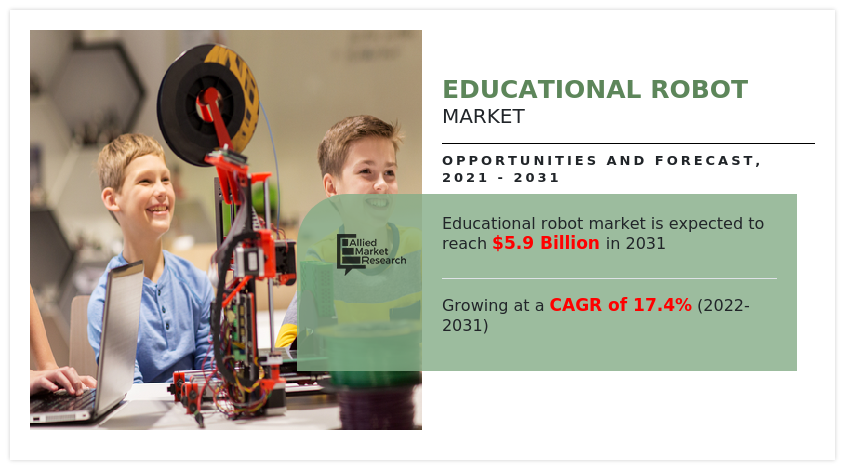
The educational robot market share is expected to witness notable growth during the forecast period, owing to a rise in investment in EdTech in emerging economies. Furthermore, the surging demand for collaborative robots in education sectors has driven the educational robot market growth. Moreover, growing research and developments related to humanoid robots to transform the service sector are expected to propel the educational robot market growth during the forecast period.
However, the high costs associated with educational robots are one of the prime factors that restrain the educational robot market outlook. On the contrary, the introduction of industrial robots in high schools is expected to provide lucrative opportunities for the growth of the educational robot market during the forecast period. Further, the lack of interoperability standards in the education robotics industry is imposing significant challenges on the educational robot market in the coming years
Segment Review:
The educational robot market is segmented into Type, Component, and End User.
On the basis of type, the educational robot market size is divided into service robots and industrial robots. The service robot segment dominated the market, in terms of revenue, in 2021, and is expected to follow the same trend during the forecast period.
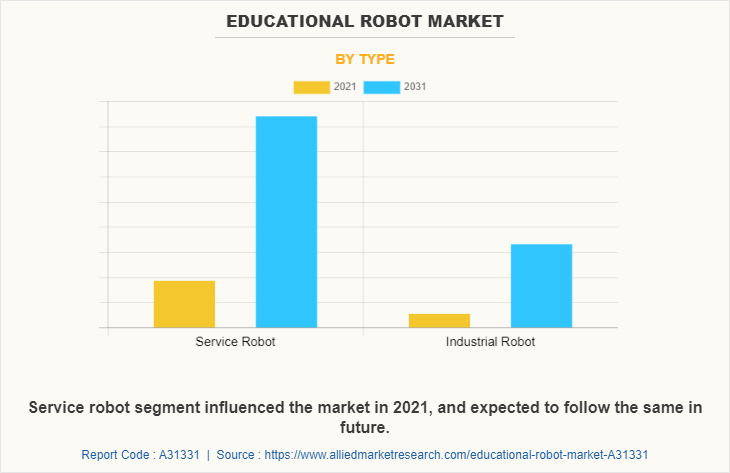
Based on components, the educational robot market forecast is bifurcated into hardware and software. The hardware segment acquired the largest share in 2021, and the BFSI segment is expected to grow at a high CAGR from 2022 to 2031.
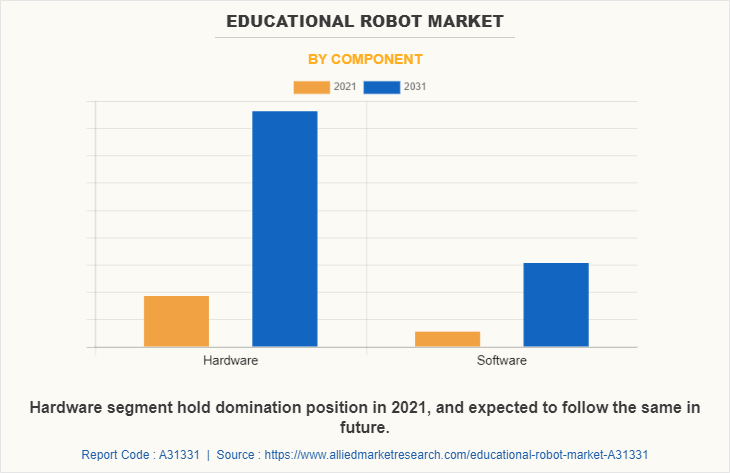
By end user, the educational robot industry is segmented into primary education, secondary education, higher education, and others. The higher-education is the main contributor in the educational robot market in 2021 and is expected to grow at a higher rate during the forecast years.
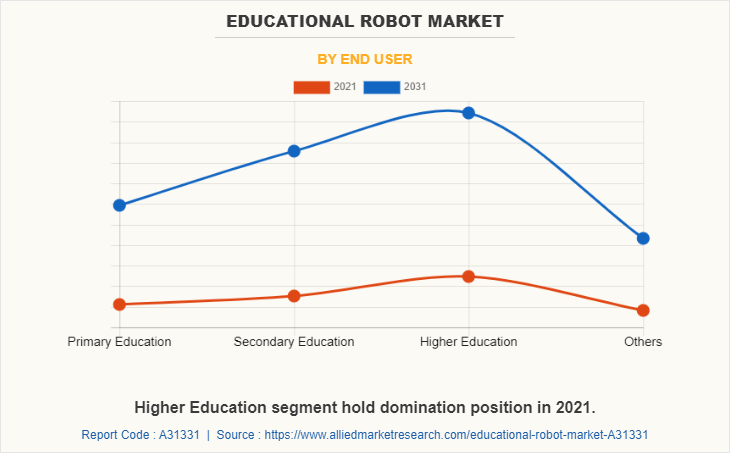
Region-wise, the educational robot market trends are analyzed across North America (the U.S., Canada, and Mexico), Europe (the UK, Germany, France, Netherlands, Spain, and the rest of Europe), Asia-Pacific (China, India, Japan, South Korea, Taiwan, and the rest of the Asia-Pacific), and LAMEA (Latin America, the Middle East, and Africa). North America, specifically the U.S., remains a significant participant in the global educational robot industry. Major organizations and government institutions in the country are intensely putting resources into technology.
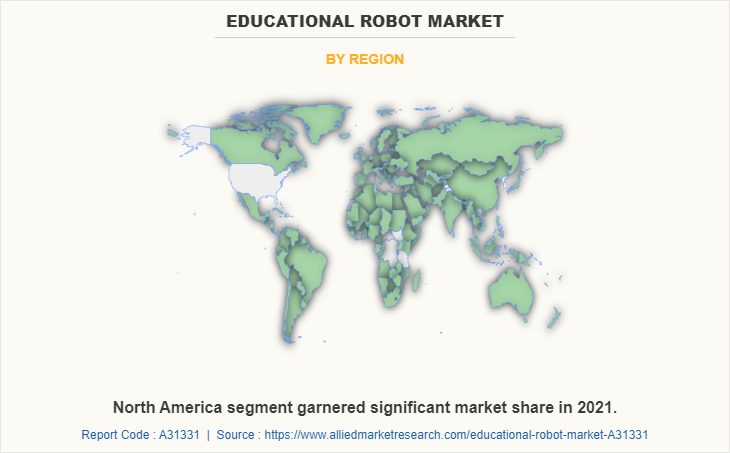
Competitive Analysis
Competitive analysis and profiles of the major educational robot market players that have been provided in the report include, such as Fanuc Corporation, ABB Ltd., YASKAWA Electric, KUKA, Universal Robots, SoftBank Robotics Group, Hanson Robotics, Robotis, Robolink, Ubtech Robotics, Seiko Epson, Hyulim Robot, Probotics America, Aisoy Robotics, Sanbot Innovation, Kinderlab Robotics, and Soapbox Labs.
Key Benefits For Stakeholders
- This report provides a quantitative analysis of the market segments, current trends, estimations, and dynamics of the educational robot market analysis from 2021 to 2031 to identify the prevailing educational robot market opportunities.
- The educational robot market research is offered along with information related to key drivers, restraints, and opportunities.
- Porter's five forces analysis highlights the potency of buyers and suppliers to enable stakeholders to make profit-oriented business decisions and strengthen their supplier-buyer network.
- An in-depth analysis of the educational robot market segmentation assists to determine the prevailing market opportunities.
- Major countries in each region are mapped according to their revenue contribution to the global educational robot market.
- Market player positioning facilitates benchmarking and provides a clear understanding of the present position of the educational robot market players.
- The report includes the analysis of the regional as well as global educational robot market trends, key players, market segments, application areas, and market growth strategies.
Educational Robot Market Report Highlights
| Aspects | Details |
| By Type |
|
| By Component |
|
| By End User |
|
| By Region |
|
| Key Market Players | YASKAWA ELECTRIC CORPORATION, SoftBank Robotics Group, Sanbot Innovation Technology, Robotis, SoapBoxLabs, Robolink, KinderLab Robotics, PROBOTICS AMERICA, UBTECH Robotics, ABB Group, FANUC CORPORATION, KUKA, Hanson Robotics, Universal Robots, Aisoy Robotics, HYULIM ROBOT, Seiko Epson Corporation |
Analyst Review
Robots can help education in a variety of ways, and they hold great promise as a learning technology. However, both researchers and educators are largely unaware of the use of robots in education. Many educators and developers have concerns about the critical applications of robots in education. Further, the rise in demand for smart infrastructure solutions in the education sector is anticipated to drive market growth in the coming years.
The global educational robot market is highly competitive, owing to the strong presence of existing vendors. Educational robot vendors, who have access to extensive technical and financial resources are anticipated to gain a competitive edge over their rivals, as they have the capacity to cater to the market requirements. The competitive environment in this market is expected to further intensify with an increase in technological innovations, product extensions, and different strategies adopted by key vendors.
The rise in demand for robotics solutions globally drives the need to enhance educational robot solutions. Moreover, prime economies, such as the U.S., China, South Korea, and Japan, plan to develop and deploy next-generation AI-based robotics solutions in the education sector, which is anticipated to provide lucrative opportunities for market growth.
Among the analyzed regions, North America exhibits the highest adoption rate of educational robots and has experienced a massive expansion of the market. On the other hand, Asia-Pacific is expected to grow at a faster pace, predicting lucrative growth opportunities for the market due to emerging countries, such as China, Japan, and India, investing in educational robot technologies. Regions, such as the Middle East and Latin America are expected to offer new opportunities in the educational robot market.
The key players profiled in the report include Fanuc Corporation, ABB Ltd., YASKAWA Electric, KUKA, Universal Robots, SoftBank Robotics Group, Hanson Robotics, Robotis, Robolink, Ubtech Robotics, Seiko Epson, Hyulim Robot, Probotics America, Aisoy Robotics, Sanbot Innovation, Kinderlab Robotics, and Soapbox Lab.
North America, specifically the U.S., remains a significant participant in the global educational robot industry.
The service robot segment dominated the market, in terms of revenue, in 2020, and is expected to follow the same trend during the forecast period.
The global educational robot market was valued at $1.19 billion in 2021 and is projected to reach $5.84 billion by 2031, registering a CAGR of 17.4% from 2022 to 2031.
Significant factors that impact the growth of the global educational robot industry include a surge in demand for collaborative robots in education sectors coupled with growing research and developments related to humanoid robots to transform the service sector.
Fanuc Corporation, ABB Ltd., YASKAWA Electric, KUKA, Universal Robots, SoftBank Robotics Group. are the top companies to hold the market share in Educational robots.
Loading Table Of Content...



